In which Sid and Doris visit Barbora and Renee on a flying visit to Slovakia
On setting out from Vienna we had little idea of the town we were going to. (And for the statistics fiends among you it was 76 kilometres away and involved a mighty 195m of ascent, mostly on and off the dykes.)
So Sid’s instant history effort: Bratislava is capital of Slovakia, has been where Hungarian monarchs were crowned and until 1919 was called Pressburg. Just after WW1 the majority of inhabitants were Hungarian and Germans. Whatever they wanted it wasn’t to be part of Czechoslovakia and declared Pozsony (the old Hungarian name) a free city. The city was taken into Czechoslovakia by armed force and given the name Bratislava. In turn Czechoslovakia was invaded by Germany with the usual effect on local diversity. The Red Army took Bratislava in April 1945 and they or their proxies stayed until 1990. (There is still a Meccano bridge, a Red Army cemetery and a larger German one.)
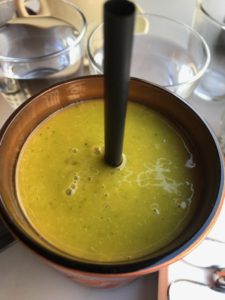
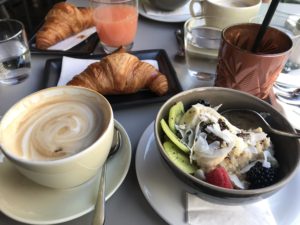 The hotel wanted 20 Euros for breakfast so we found top rations in the Joma cafe by the Romer Museum, including this green swamp drink, so thick the straw stands up, ordered (and drunk! yes I did and it was jolly nice – D.) by Doris. After breakfast we went to Freytag and Berndt travellers’ bookshop and bought three Bikeline guides to the Danube cycle paths, which should help our routing and show where to detour for historical interest and better conditorei.
The hotel wanted 20 Euros for breakfast so we found top rations in the Joma cafe by the Romer Museum, including this green swamp drink, so thick the straw stands up, ordered (and drunk! yes I did and it was jolly nice – D.) by Doris. After breakfast we went to Freytag and Berndt travellers’ bookshop and bought three Bikeline guides to the Danube cycle paths, which should help our routing and show where to detour for historical interest and better conditorei.
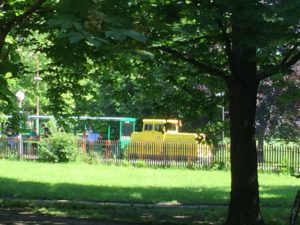
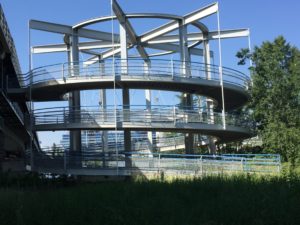 Our way out of Vienna was through the Prater woods. The general delight only increased by the presence of a ride-on mini railway.
Our way out of Vienna was through the Prater woods. The general delight only increased by the presence of a ride-on mini railway.
To get over the river we were again on abandoned over passes and then this spiral, the sort of thing rich countries with cyclists can afford, and contrasts with our lifting the bikes up stairs in Czechia.
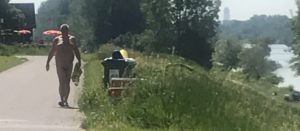 Out into the country Miftah Bat was in for a great treat where along the river many bronzed and wrinkly Austrian naturists had declared for all in sunbathing. Bottoms, tee hee, hee and everything. We have no erotic pictures, they just weren’t.
Out into the country Miftah Bat was in for a great treat where along the river many bronzed and wrinkly Austrian naturists had declared for all in sunbathing. Bottoms, tee hee, hee and everything. We have no erotic pictures, they just weren’t.
Further along we find Sid admiring a huge OMV tank farm we ran through. Acres of tanks, pumps, valves. Look, you can’t afford all these bike paths and pensions for naturists from sewing dirndls, you just can’t.
The mid part of the day required large detours through farm land on gravel tracks eventually being deliberately diverted round the fine Schloss Eckartsau. Later we crossed the river on very long bridge, stilts across the flood plain at tree canopy height and then a long span of suspension bridge. Cyclists had been given a lane fenced off but it did all feel a bit exposed
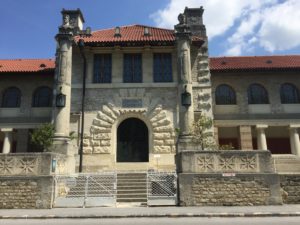 Of course this area has been fought over by Turks and Hungarians but before them came the Legionnaries. We detoured to see the Roman baths at Carnuntum (though did not actually see them as now inside) which were abandoned along with the nearby camp about 400AD. The Germans had no need of baths until Franz Josef 1st built this fine museum.
Of course this area has been fought over by Turks and Hungarians but before them came the Legionnaries. We detoured to see the Roman baths at Carnuntum (though did not actually see them as now inside) which were abandoned along with the nearby camp about 400AD. The Germans had no need of baths until Franz Josef 1st built this fine museum.
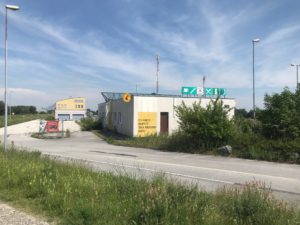
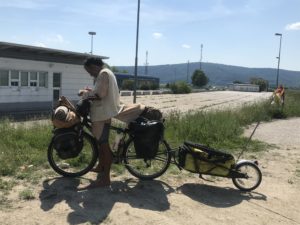 A couple of sights still to show you. One is the fun of a forlorn border crossing, once on the Iron Curtain Border and therefore once carefully policed. Possibly this traveller would have aroused interest?
A couple of sights still to show you. One is the fun of a forlorn border crossing, once on the Iron Curtain Border and therefore once carefully policed. Possibly this traveller would have aroused interest?
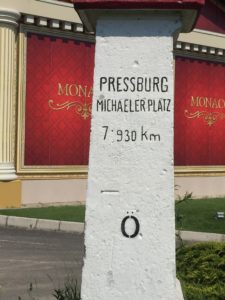 And a milestone saying we are only 7.930 kilometres from Pressburg (the previous, or possibly current in Czech, name for Bratislava).
And a milestone saying we are only 7.930 kilometres from Pressburg (the previous, or possibly current in Czech, name for Bratislava).
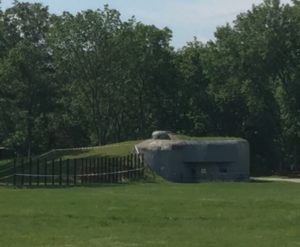
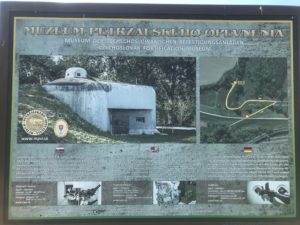 And last is this restored Czech pill box Bunker BS4 on the Benesova Line to protect against either a German or Hungarian invasion, exactly the model Sid picked out in the Czech Technical Museum all those days ago. Lovely when it all joins up (as so much has in Bratislava).
And last is this restored Czech pill box Bunker BS4 on the Benesova Line to protect against either a German or Hungarian invasion, exactly the model Sid picked out in the Czech Technical Museum all those days ago. Lovely when it all joins up (as so much has in Bratislava).
However the one thing that hasn’t joined up is the railway line, which finishes in Wolfstahl just a km or so short of the border, with a car park full of Czech cars making the commute the rest of the way into Vienna by train.
Tonight’s lodgin’ is excellent. An apartment on the Michalska. You will be pleased for us that it has a washing machine, hurrah. And best of all we are out to dinner with Barbora and Rene at the Gatto Matto.
So, in hindsight we saw some things. Frankly some days just will not have much epic content but with our new map books we may see more.